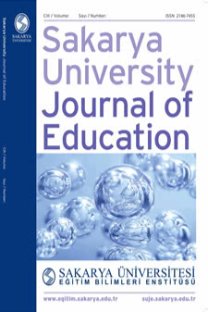Document analysis of school district policies on advanced programs, ınternational baccalaureate, and dual credit programs in the United States
Bu çalışmanın amacı, Amerika Birleşik Devletleri genelinde uygulanan, lisede okurken üniversitede saydırılabilecek dersleri alma (Advance Placement), Uluslararası Diploma (International Baccalaureate) ve alınan dersi hem lise hem de sonrasında üniversite transkriptinde göstererek Çift Kredilendirme (Dual Credit) programları ile ilgili belgeleri incelemektir. Bu sayede farklı uygulamalar arasındaki, benzerlikleri ve farklılıkları ilgili belgelerden tespit etmek, öğrenci ve aileler için bu belgelerin ne derece okunabilir ve anlaşılabilir olduklarını belirlemek hedeflenmiştir. Doküman analizi yöntemi kullanılan bu çalışmada, Amerika Birleşik Devletleri genelinden rastgele seçilen 42 okul bölgesinin sözü edilen programlarla ilgili kılavuzluk etme amacıyla hazırlanan başvuru, yerleştirme, bilgilendirme vb. amaçlı belgeleri araştırmanın verilerini oluşturmuştur. Her bir yönetmeliğin okunabilirlik puanı FleschKincaid okunabilirlik testi ile ölçülmüş, ve kolay okunabilirlik puan kılavuzuna göre değerlendirilmiştir. Çalışma elde edilen sonuçlara dayalı olarak uygulamaya yönelik önerilerde bulunulmuştur.
Amerika birleşik devletlerinde uygulanan; lisede ders alıp üniversitede saydırma, uluslararası diploma ve çift kredilendirme programları belgelerinin incelenmesi
The aim of the study was to investigate the similarities and differences among the school district policies on Advanced Placement, International Baccalaureate, and Dual Credit programs across the United States and how complicated the policies are for parents and students to read and comprehend. The study was designed as a document analysis in which a total of forty-two school districts were randomly selected across the nation, and their policies on these three advanced programs were used as the data source. Flesch-Kincaid readability test was employed to measure the readability of the each district policy based on the pattern of reading ease score guideline. In addition, implications for practice were given based on the findings of the study.
___
- Barnett, E., & Stamm, L. (2010). Dual Enrollment: A Strategy for Educational Advancement of all Students. Washington, DC: Blackboard Institute.
- Bowen, G. A. (2009). Document analysis as a qualitative research method, Qualitative Research Journal, 27-40.
- Charlotte Mecklenburg Schools. (2002). Concurrent Enrollment. Retrieved from http://www.cms.k12. nc.us/Pages/Default.aspx.
- Charlotte Mecklenburg Schools. (2005). Honors Progam. Retrieved from http://www.cms.k12.nc.us/ Pages/Default.aspx.
- College Board. (2003). A Brief History of the Advanced Placement Program. Retrieved from www.collegeboard.com/prod_downloads/about/newsinfo/ap/aphistoryenglish.pdf.
- Creswell, J. W. (2007). Qualitative Inquiry and Research Design: Choosing among Five Approaches, Sage.
- Doak, C. C., Doak, L. G., & Root, J. H. (1996). Teaching patients with low literacy skills. AJN The American Journal of Nursing, 96(12), 16M.
- Dudley, D. A. (1958). The Advanced Placement Program. NASSP Bulletin, 42 (December), 15.
- Erlandson, A. D., Harris, L. E., Skipper, L., B, and Allen, D. S. (1993). Doing Naturalistic Inquiry: A Guide to Methods. Sage Publications, Newbury Park, CA.
- Geiser, S., Santelices, V., & California Univ, B. C. f. S. i. H. E. (2004). The Role of Advanced Placement and Honors Courses in College Admissions. Research & Occasional Paper Series: CSHE.4.04: Center for Studies in Higher Education.
- Hoffman, N., Vargas, J., & Santos, J. (2009). New directions for dual enrollment: Creating stronger pathways from high school through college. New Directions for Community Colleges, 43-58. doi: 10.1002/cc.354
- Iatarola, P., Conger, D., & Long, M. C. (2011). Determinants of High Schools' Advanced Course Offer- ings. Educational Evaluation and Policy Analysis, 33(3), 340-359.
- International Baccalaureate Organization. (2013). Retrieved from www.ibo.org
- Jackson, C. K. (2010). A Little Now for a Lot Later. Journal of Human Resources, 45(3), 591-639.
- Karp, M. M., Bailey, T. R., Hughes, K. L., Fermin, B. J., & Office of Vocational and Adult Education, W. D. C. (2004). State Dual Enrollment Policies: Addressing Access and Quality: US Department of Education.
- Kim, J., Kirby, C., Bragg, D. D., & Illinois Univ, C. O. o. C. C. R. a. L. (2004). Dual Credit: Then and Now. In Brief: Office of Community College Research and Leadership.
- Lewin, T. (2010). International Program Catches on in U.S. Schools, The New York Times.
- Mathews, J. (2005). How to Build a Better High School. Newsweek, 145(20), 52-57.
- Merriam, S. B. (1988). Case Study Research in Education: A Qualitative Approach, Jossey-Bass, San Fran- cisco.
- Moore, G. W., & Slate, J. R. (2008). Who's Taking the Advanced Placement Courses and How Are They Doing: A Statewide Two-Year Study. High School Journal, 92(1), 56-67.
- Polishchuk, D. L., Hashem, J., & Sabharwal, S. (2012). Readability of online patient education materi- als on adult reconstruction web sites. Journal of Arthroplasty, 27(5), 716-719.
- Schneider, J. (2009). Privilege, equity, and the Advanced Placement Program: tug of war. Journal of Curriculum Studies, 41(6), 813-831. doi: 10.1080/00220270802713613
- Yonezawa, S., Wells, A. S., & Serna, I. (2002). Choosing Tracks: "Freedom of Choice" in Detracking Schools. American Educational Research Journal, 39(1), 37-67.
- Young, R. D., Joyner, S. A., & Slate, J. R. (2013). Grade Point Average Differences between Dual and Nondual Credit College Students. Urban Studies Research, 6.
- ISSN: 2146-7455
- Yayın Aralığı: Yılda 3 Sayı
- Başlangıç: 2011
- Yayıncı: Sakarya Üniversitesi Eğitim Bilimleri Enstitüsü
Sayıdaki Diğer Makaleler
İlköğretim İkinci Kademe Öğrencileri Sosyal Sermaye Ölçeği Adaptasyon Çalışması
Türkiye’de Akademisyenlerin Kitap Yazmaya Bakış Açıları: Sakarya Üniversitesi Örneği
Sevket CETIN, Connor MOORE, Bonnie BOWMAN
Türkiye'de akademisyenlerin kitap yazmaya bakış açıları: Sakarya üniversitesi örneği
Melike YAVUZ, Fatime BALKAN KIYICI, Elif ATABEK YİĞİT
Şevket Ceyhun ÇETİN, Conner MOORE, Bonnie BOWMAN
